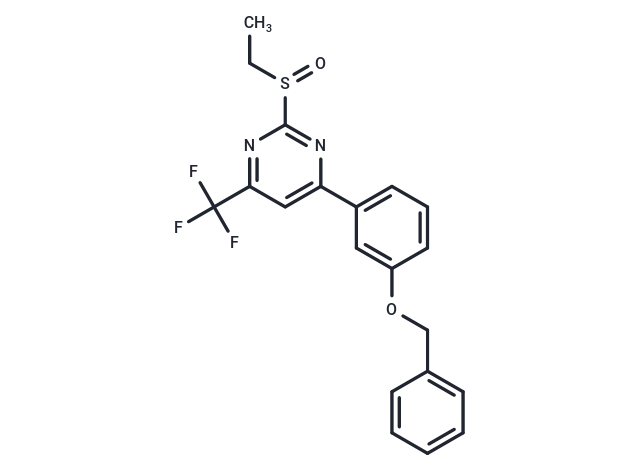Shopping Cart
- Remove All
 Your shopping cart is currently empty
Your shopping cart is currently empty

BETP is an agonist of GLP-1 receptor (EC50s: 0.66 and 0.755 μM for human and rat GLP-1 receptor).

| Pack Size | Price | Availability | Quantity |
|---|---|---|---|
| 1 mg | $40 | In Stock | |
| 5 mg | $85 | In Stock | |
| 10 mg | $142 | In Stock | |
| 25 mg | $278 | In Stock | |
| 50 mg | $446 | In Stock | |
| 100 mg | $712 | In Stock | |
| 1 mL x 10 mM (in DMSO) | $98 | In Stock |
| Description | BETP is an agonist of GLP-1 receptor (EC50s: 0.66 and 0.755 μM for human and rat GLP-1 receptor). |
| Targets&IC50 | GLP1:0.755 μM(Rat), GLP1:0.66 μM(Human) |
| In vitro | BETP (Compound B) is inactive in cells expressing the GLP-2, GIP, PTH, or glucagon receptors. BETP (1-10 μM) enhances insulin secretion in normal and diabetic human islets. In addition, BETP in combination with GLP-1 shows additive effects on increasing GLP-1 receptor signaling [1]. BETP increases the potency of oxyntomodulin by 10-fold (EC50: 80 pM). GLP-1 does not change the potencies and efficacies of both oxyntomodulin and glucagon at the glucagon receptor. BETP (0-30 μM) increases the binding affinity of oxyntomodulin for the GLP-1 receptor [2]. |
| In vivo | BETP (10 mg/kg, jugular vein cannula) exhibits insulin secretagogue activity in the intravenous glucose tolerance test (IVGTT) model. BETP (10 mg/kg, i.v.)-treated rats need 20% higher glucose infusion rates and demonstrate higher plasma insulin levels in the SD rat hyperglycemic clamp model [1]. BETP (5 mg/kg) enhances oxyntomodulin-stimulated insulin secretion [2]. |
| Animal Research | IVGTT studies are performed. Male SD rats are group-housed three per cage in polycarbonate cages with filter tops. Rats are maintained on a 12:12 h light-dark cycle (lights on at 6:00 a.m.) at 21°C and receive diet and deionized water ad libitum. Rats were fasted overnight and anesthetized with 60 mg/kg pentobarbital for the duration of the experiment. For glucose and compounds (BETP, etc.) administration, a catheter with a diameter of 0.84 mm is inserted into the jugular vein. For rapid blood collection, a larger catheter with 1.02-mm diameter is inserted into the carotid artery. Blood is collected for glucose and insulin levels at times 0, 2, 4, 6, 10, and 20 min after intravenous administration of the BETP which is immediately followed by an intravenous glucose bolus of 0.5 g/kg. Plasma levels of glucose and insulin are determined [1]. |
| Molecular Weight | 406.42 |
| Formula | C20H17F3N2O2S |
| Cas No. | 1371569-69-5 |
| Smiles | CCS(=O)c1nc(cc(n1)C(F)(F)F)-c1cccc(OCc2ccccc2)c1 |
| Relative Density. | 1.39 g/cm3 (Predicted) |
| Storage | Powder: -20°C for 3 years | In solvent: -80°C for 1 year | Shipping with blue ice. | ||||||||||||||||||||||||||||||
| Solubility Information | H2O: Insoluble DMSO: 25 mg/mL (61.51 mM), Sonication is recommended. | ||||||||||||||||||||||||||||||
Solution Preparation Table | |||||||||||||||||||||||||||||||
DMSO
| |||||||||||||||||||||||||||||||

Copyright © 2015-2025 TargetMol Chemicals Inc. All Rights Reserved.